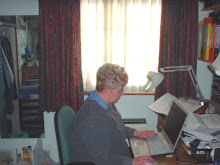When I completed St Andrew's Ward at the beginning of August, I thought I would be taking a three to four week transcription break before continuing on with St Patrick's, the final area to be done.
However, our Family History Centre and local LDS church unexpectedly decided to have the builders in and the centre is now closed for ten weeks or so. With no transcription to do I am keeping myself busy with other tasks in connection with the project: proofreading, comparing census data with city directories, reading histories of the period, and drawing maps.
Proofreading is being done with the assistance of Ancestry's provision of the original microfilms online. They now also bring up the transcription provided to them by the LDS FamilySearch Indexing project and allow any viewer to suggest alterations. As a result I am proofreading my transcription and theirs at the same time. They both contain errors. Hopefully, at the end of the day, the names in both will be the same.
Proofreading is a fairly slow activity and has a fairly early "yawn" threshold. However, I have almost completed St David's Ward which I transcribed four years ago. It is a lot easier to read a computer monitor than it was to figure out the same information on a microfilm screen. There is more magnification available and computer monitors tend to be cleaner.
Comparing the data from the census with city directories is something I have done quite a bit of ever since I started transcribing. It's nice to know exactly where a family lived and every once in a while the directory's entry sorts out legibility difficulties provided by the census. Of course, sometimes the directory gets something wrong, too. Let's face it, on cloudy days they would have been proofread by gaslight. And all the indexing was done by hand and eye and brain while we present a great list to our computer's software and, presto, it's done.
Last week I discovered that Amazon UK carries some books on Toronto history. As a result I now have copies of Eric Arthur's Toronto, No Mean City and two of Mike Filey's Sketches of the Way We Were. It's amazing how much I have learned about 19th century Toronto since I opened these books on Saturday.
Drawing maps is strictly a computer activity. I am no artist, but with a mouse I can draw a straight line. A drawing program called paint.net lets me trace from a map found online or scanned from a book. The original is the background layer. Then I add a pale solid colour as a translucent layer, then another layer on which I outline the streets and a third where I write the street names. When I'm finished I hide the original and I have a fairly easy-to-read street map. The streets on my map follow an even stricter grid pattern that Toronto planners provided us with in the first place. My father was a draughtsman who retired at about the same time as computers came on the scene. He would have been green with envy.
There's plenty to do, even without actually transcribing.
Tuesday, 1 September 2009
Keeping Busy in an Interim Period
Labels:
"Toronto,
city directories,
drawing maps,
No Mean City",
paint.net,
proofreading
Subscribe to:
Post Comments (Atom)




No comments:
Post a Comment